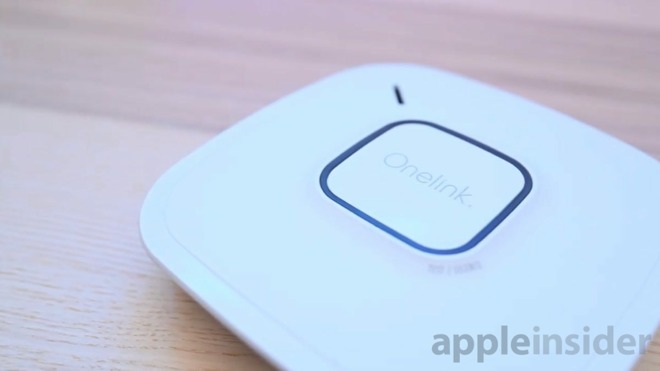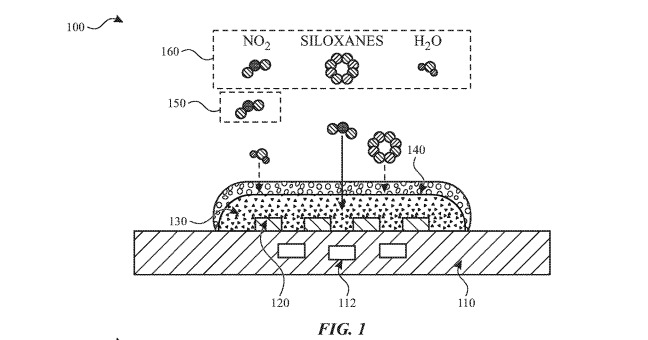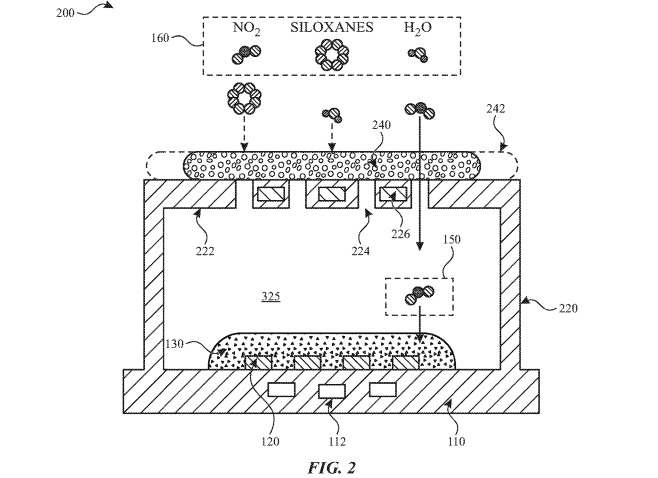Environmental & poisonous gas sensors on a future iPhone could save your life
Apple is exploring the possibility of integrating miniature gas sensors in HomeKit devices and the iPhone that could detect poisonous gases and other environmental hazards and alert the user to their presence.

OneLink Smart Smoke and Carbon Monoxide Alarm, a HomeKit-enabled sensing device for the home.
One of the hidden hazards in the world is poisonous gas, a danger which can be hard for people to notice at all in some instances. Airborne chemicals like carbon monoxide are not able to be smelled or seen by humans, but have the potential to kill if not dealt with in a timely fashion.
The problem with this sort of threat is that it requires some sort of indicator or detection device, with current solutions available including carbon monoxide sensors able to protect the user's home.
In a patent application published by the U.S. Patent and Trademark Office on Tuesday, Apple suggests adding such a sensor to devices, including those in smart home and Internet of Things product categories, as well as those under "health monitoring," which could feasibly include iPhones or the Apple Watch.
While adding a gas detector to a device isn't entirely novel, the patent application "chemically robust miniature gas sensors" goes further, in suggesting the creation of sensors that maintain their accuracy.
Metal oxide gas sensors are said by Apple to be "among the most promising technologies" to be added to consumer devices, due to their small size, low power consumption, compatibility with semiconductor fabrication processes, and a simple architecture. However, Apple warns humidity, the chemical poisoning and deactivation of sensor materials can cause drift in both baseline resistance and sensitivity, affecting its performance and potentially failing the hardware, making it useless.

An illustration of Apple's proposed gas sensor protected by an adsorbent layer.
Apple's solution is the creation of a silicon-based substrate with electrodes deposited on the substrate, a gas-sensing layer covering the electrodes, and an adsorbent layer that can selectively filter components of a gas mixture. The adsorbent layer is able to selectively filter the gas mixture to only allow target gases through, such as carbon monoxide or methane, to the gas-sensing layer.
To keep the sensor arrangement live, it is suggested heating elements are added to the substrate and are periodically operated, in order to refresh the gas-sensing layer.
The proposed sensor could be used to detect multiple common gases, with the gas-sensing layer able to be constructed from a granular metal oxide semiconductor material. The layer could be configured to convert a target gas concentration into electrical resistance.
While the adsorbent layer could be laid directly on top of the sensor layer, Apple also proposes the possibility of the sensor being held in an enclosure, with the adsorbent layer on the outside of the casing, covering openings. The adsorbent layer could let target gases the sensor could detect through the openings and to the sensor itself.

A second illustration, showing the enclosure-based design that separates the adsorbent layer from the rest of the sensor.
Apple adds that a second set of heating elements could be added to the enclosure, allowing for control of gas flow. With the first elements on and the second enclosure elements off, the system is in a position that allows for "poison removal," namely encouraging it to dissipate around the sensor. Reversing the heating element states are said to help a "regeneration operation" take place.
Apple issues a large number of patents and applications on a weekly basis, and while they illustrate where Apple has focused in the last, it is not a guarantee that the concepts described will be introduced as part of a commercial product or service.
Creating small and easy-to-integrate gas sensors would offer the opportunity to have more of the sensors in a home, as well as for devices to sense multiple gases at the same time instead of the single-gas detectors currently offered on the consumer marketplace. HomeKit safety devices could become more prevalent, and could even be used to warn homeowners of a gas leak while they are at work or away from the home itself.
If Apple went down the route of adding them to "health monitoring" devices, this could in effect allow iPhones and the Apple Watch to become a personal gas detector that travels around with its user at almost all times. This portability would allow for added safety when users are out and about in their daily lives, a scenario that typically does not offer much in the way of poisonous gas protection.
This is not the first time Apple has considered warning users of environmental dangers. In a December 2016 patent application called "Electronic device with speaker enclosure sensor," Apple suggested adding an environmental sensor within a speaker cavity, giving it some protection from the elements while allowing the natural air movement of the speaker diaphragm to help it collect samples.

OneLink Smart Smoke and Carbon Monoxide Alarm, a HomeKit-enabled sensing device for the home.
One of the hidden hazards in the world is poisonous gas, a danger which can be hard for people to notice at all in some instances. Airborne chemicals like carbon monoxide are not able to be smelled or seen by humans, but have the potential to kill if not dealt with in a timely fashion.
The problem with this sort of threat is that it requires some sort of indicator or detection device, with current solutions available including carbon monoxide sensors able to protect the user's home.
In a patent application published by the U.S. Patent and Trademark Office on Tuesday, Apple suggests adding such a sensor to devices, including those in smart home and Internet of Things product categories, as well as those under "health monitoring," which could feasibly include iPhones or the Apple Watch.
While adding a gas detector to a device isn't entirely novel, the patent application "chemically robust miniature gas sensors" goes further, in suggesting the creation of sensors that maintain their accuracy.
Metal oxide gas sensors are said by Apple to be "among the most promising technologies" to be added to consumer devices, due to their small size, low power consumption, compatibility with semiconductor fabrication processes, and a simple architecture. However, Apple warns humidity, the chemical poisoning and deactivation of sensor materials can cause drift in both baseline resistance and sensitivity, affecting its performance and potentially failing the hardware, making it useless.

An illustration of Apple's proposed gas sensor protected by an adsorbent layer.
Apple's solution is the creation of a silicon-based substrate with electrodes deposited on the substrate, a gas-sensing layer covering the electrodes, and an adsorbent layer that can selectively filter components of a gas mixture. The adsorbent layer is able to selectively filter the gas mixture to only allow target gases through, such as carbon monoxide or methane, to the gas-sensing layer.
To keep the sensor arrangement live, it is suggested heating elements are added to the substrate and are periodically operated, in order to refresh the gas-sensing layer.
The proposed sensor could be used to detect multiple common gases, with the gas-sensing layer able to be constructed from a granular metal oxide semiconductor material. The layer could be configured to convert a target gas concentration into electrical resistance.
While the adsorbent layer could be laid directly on top of the sensor layer, Apple also proposes the possibility of the sensor being held in an enclosure, with the adsorbent layer on the outside of the casing, covering openings. The adsorbent layer could let target gases the sensor could detect through the openings and to the sensor itself.

A second illustration, showing the enclosure-based design that separates the adsorbent layer from the rest of the sensor.
Apple adds that a second set of heating elements could be added to the enclosure, allowing for control of gas flow. With the first elements on and the second enclosure elements off, the system is in a position that allows for "poison removal," namely encouraging it to dissipate around the sensor. Reversing the heating element states are said to help a "regeneration operation" take place.
Apple issues a large number of patents and applications on a weekly basis, and while they illustrate where Apple has focused in the last, it is not a guarantee that the concepts described will be introduced as part of a commercial product or service.
Creating small and easy-to-integrate gas sensors would offer the opportunity to have more of the sensors in a home, as well as for devices to sense multiple gases at the same time instead of the single-gas detectors currently offered on the consumer marketplace. HomeKit safety devices could become more prevalent, and could even be used to warn homeowners of a gas leak while they are at work or away from the home itself.
If Apple went down the route of adding them to "health monitoring" devices, this could in effect allow iPhones and the Apple Watch to become a personal gas detector that travels around with its user at almost all times. This portability would allow for added safety when users are out and about in their daily lives, a scenario that typically does not offer much in the way of poisonous gas protection.
This is not the first time Apple has considered warning users of environmental dangers. In a December 2016 patent application called "Electronic device with speaker enclosure sensor," Apple suggested adding an environmental sensor within a speaker cavity, giving it some protection from the elements while allowing the natural air movement of the speaker diaphragm to help it collect samples.

Comments
Many people die every year because of Carbon Monoxide. You CAN'T smell it. You can smell Natural Gas, ONLY because they actually add the smell to it to make it safer. People have done dumb things like run a power Generator inside their house because the power is out and they don't want someone to come along and steal it if it's outside. As the whole family is sleeping that generator is killing them in their sleep. It's the same effect as running your car inside a garage with the door closed. You get drowsy, fall asleep and then die. You can't smell Carbon Monoxide!!!! You want to make sure your Detector is always working just like your Smoke Alarms. Even more so during the Winter when your Heater is always running and you have all your windows closed. It's cold outside after all.
I'd also like them to add oxygen level sensors for people who enter and work in enclosed spaces like mines, storage tanks, shipboard voids, etc. Also, ozone and chlorine gas sensors would be helpful. A radiation sensor or resettable radiation dosimeter should also be considered for people who work around medical and industrial imaging systems.